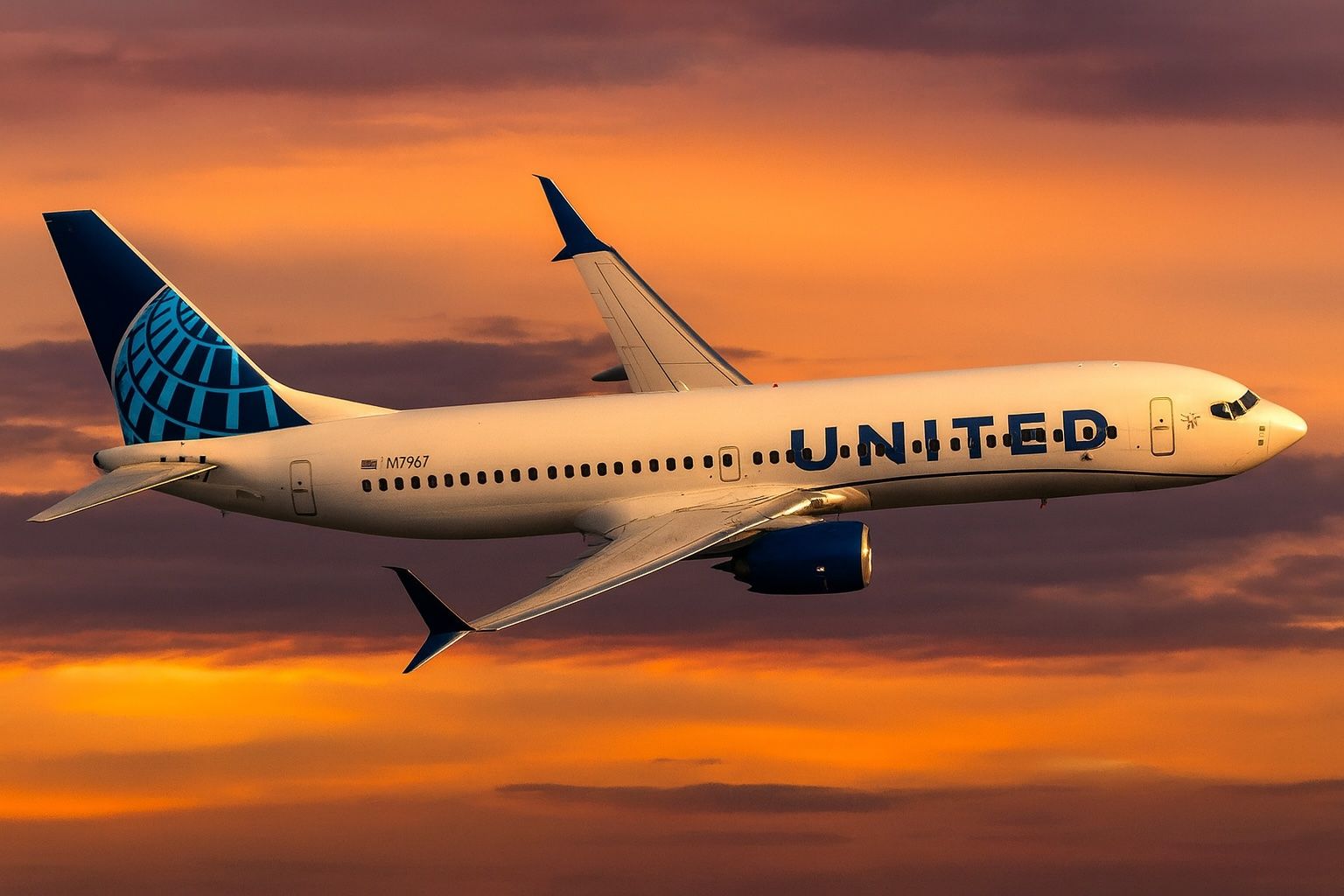- Stock Rally: UAL shares climbed sharply ahead of earnings, closing around $99.25 on Oct 13 (+2.7%) [1] and about $104.18 on Oct 15 [2]. The stock is up roughly 13% over the past three months and nearly 45% year-over-year [3].
- Q3 Results: United reported adjusted Q3 EPS of $2.78, beating the ~$2.63 Wall Street consensus [4] [5]. Third-quarter revenue was $15.2 billion (up 2.6% YoY), narrowly below the $15.33 billion estimate [6]. A strong mix of premium and loyalty sales helped the beat.
- Q4 Outlook Raised: UAL issued very strong guidance – adjusted EPS of $3.00–$3.50 for Q4, well above the $2.86 consensus [7]. Management said fourth-quarter revenue should hit the highest-ever quarterly level as travel demand climbs. The stock jumped further in after-hours trading (~+1–1.5% [8] [9]) on the upbeat outlook.
- Analyst Sentiment: The analyst consensus is a Buy on UAL, with the average 12-month price target around $120–$121 (about 16% above current levels) [10] [11]. Many firms highlight UAL’s focus on premium travelers and improving margins.
- Peer Strength: UAL’s rise coincided with strong industry earnings. Delta Air Lines surprised with robust Q3 results (adjusted EPS $1.71 vs. $1.52 est.) [12], lifting confidence across airline stocks. Along with Delta, United has been a top performer by leaning on high-margin business and international travel [13].
- Industry Factors: Air travel demand remains resilient despite economic headwinds. Cuts to seat capacity (Spirit’s pullback, moderation of other carriers’ growth) have bolstered fares [14]. Meanwhile, jet fuel has eased – the U.S. jet fuel spot price was about $2.32 per gallon on Oct 14, 2025 [15] (around United’s Q3 average of $2.43 [16]).
- Other News: United recently announced new international routes (e.g. summer 2026 service to Split, Glasgow, Bari) [17]. It also unveiled a partnership with Instacart allowing MileagePlus members to earn grocery rewards [18]. In labor, United’s flight attendants resumed contract talks in early October [19].
Stock Performance This Week
United’s stock has climbed steadily into the third-quarter earnings release. On Monday, Oct. 13, UAL closed at $99.25, up 2.7% on the day [20], and above the week’s open. By Tuesday (Oct. 14) it traded around $103–$104 per share, and it closed Oct. 15 near $104.18 [21]. This marks roughly a 5% gain in two days and a roughly 13% gain over the last three months [22]. The advance came as peers rallied: notably, Delta’s Oct. 9 earnings beat sent airline stocks higher [23]. Market bulls cite United’s positioning in premium and global travel; bears note airlines’ general volatility and high debt. Still, UAL’s recent surge reflects optimism that demand remains strong heading into year-end.
Third-Quarter Results and Guidance
United’s Q3 earnings were broadly better than analysts expected. Reported on Oct. 15 after markets closed, UAL posted adjusted EPS of $2.78 (above the $2.67–$2.68 consensus [24] [25]) and revenue $15.2 billion, up 2.6% year-over-year [26]. Pre-tax profit was $1.3 billion (8.2% margin) [27]. Revenue gains were broad-based: premium cabin sales rose ~6% YoY, frequent-flyer (loyalty) revenue +9%, while Basic Economy and cargo also grew [28] [29]. CEO Scott Kirby noted that investments in cabins, in-flight Wi-Fi (Starlink), and service have built “brand-loyal customers” who help United be resilient through economic swings [30] [31].
Crucially, United raised its outlook. It now expects adjusted Q4 EPS of $3.00–$3.50 [32], implying a midpoint (~$3.25) well above the ~$2.86 analyst forecast [33]. Management emphasized that seasonal demand and higher fares (from capacity cuts industry-wide) should drive record quarterly revenue and profit [34] [35]. In other words, even though UAL said operational issues at Newark had pressured its unit revenue in Q3, they expect a “meaningful improvement” as airport congestion eases [36]. After the announcement, UAL stock ticked up about 1–1.5% in after-hours trading [37] [38], reflecting investor approval of the beat and the very strong Q4 guidance.
Recent United Airlines News
United has been in the headlines beyond just earnings. On Oct. 6 the company announced a new partnership with Instacart: members of United’s MileagePlus loyalty program can now earn grocery shopping rewards on Instacart orders [39]. The airline is also expanding its network: in mid-October it announced summer 2026 service to several new European destinations (Split, Croatia; Glasgow, Scotland; Bari, Italy; etc.) [40]. These route additions build on last summer’s Atlantic expansion and underline United’s strength as “the largest carrier across the Atlantic” with service to 46 cities planned for 2026 [41]. Operationally, United flew its largest-ever summer schedule this year with record completion rates and improved reliability [42], which management said contributes to customer loyalty.
Labor negotiations remain a watch item. In early October, United’s flight attendants union resumed contract talks amid a looming partial government shutdown [43]. Pilots and other unions have also been bargaining this year. So far, none of these talks has significantly disrupted operations, but investors are monitoring whether labor costs or disputes could emerge as headwinds in 2026.
Analyst Commentary and Forecasts
Industry analysts have generally applauded United’s strategy and results. For example, a Benzinga analyst noted on Oct. 9 that “United shares appear to be trading higher … as investors view Delta’s strong earnings as a sign of broader strength across the airline industry” [44]. Indeed, Wall Street’s most recent consensus is strongly bullish on UAL: TipRanks reports the average analyst rating is Buy with a $121 target [45], and MarketBeat finds a consensus 12-month price target of about $120.64 (roughly 16% above the then-current price) [46]. Many analysts cite United’s success in the premium-cabin and loyalty segments as key drivers, noting that UAL (like Delta) focuses on higher-yield customers.
On the Q3 earnings call, some analysts asked about pricing power and capacity. In commentary, Reuters noted that airlines have trimmed capacity (Spirit scaled back, others slowing growth), which is expected to keep fares “up” [47]. United management echoed this view, saying U.S. carriers see less discounting now. UAL also highlighted ongoing investments – e.g. upgrading Polaris business-class seats, installing Starlink Wi-Fi across the fleet, and revamping lounges – which it argues will cement customer preference. CEO Kirby put it this way: “Customers are increasingly choosing an airline that can deliver value for them across the full travel experience” [48].
In terms of direct price forecasts, mainstream institutions have UAL targets mostly in the low $120s. (By comparison, the stock traded around $104 after the report [49].) Any meaningful economic slowdown or spike in fuel could pressure these forecasts, but for now the sentiment remains that United is a leader in what analysts call the “new paradigm” of stronger airline fundamentals.
Industry and Market Context
United’s news comes in a generally positive context for U.S. airlines. Third-quarter earnings season has seen beaten estimates across the sector. Delta not only beat Q3 estimates (reporting $1.71 EPS [50]) but also issued a very strong Q4 outlook, which lifted American and United stocks as well. By focusing on corporate and premium leisure travelers, United and Delta have seen profitability diverge from more price-sensitive carriers like Southwest or JetBlue (which have flagged weaker leisure demand).
Macro factors are mixed but not dire. Jet fuel prices have eased after spiking in 2022–24; as of mid-October, the U.S. jet-fuel spot average is about $2.30–$2.40 per gallon [51], roughly in line with United’s Q3 cost of $2.43 [52]. Broader U.S. economic growth has been moderate but consumer spending on travel remains high, buoyed by solid employment. The Federal Reserve’s likely pause in rate hikes (markets are currently betting on a dovish turn) also helps consumer sentiment. All told, the sector outlook is characterized by firm summer demand, strong holiday bookings (especially for premium cabins), and reduced risk of industry overcapacity.
On the stock market side, UAL’s performance ties to the overall “cyclical recovery” theme. If the S&P 500’s earnings growth slows (analysts see ~8–9% growth in Q3 vs 13% in Q2 [53]), companies like United still benefit from the solid travel rebound. Still, investors will be watching any signs of a broader economic slowdown or geopolitical shock. For now, United’s combination of a beat-and-raise quarter and positive industry trends has made its shares one of the standout performers on Oct. 15.
Sources: Company SEC filings and press releases [54] [55]; regulatory filings and earnings news from Investing.com and Reuters [56] [57]; market data from Investing.com [58] and Benzinga [59]; industry data from Airlines for America [60]; various financial news and analysis outlets [61] [62] [63].
References
1. daytraders.com, 2. www.investing.com, 3. www.investing.com, 4. www.investing.com, 5. www.reuters.com, 6. www.investing.com, 7. www.reuters.com, 8. www.investing.com, 9. www.reuters.com, 10. www.tipranks.com, 11. www.marketbeat.com, 12. www.benzinga.com, 13. www.reuters.com, 14. www.reuters.com, 15. www.airlines.org, 16. www.prnewswire.com, 17. www.prnewswire.com, 18. daytraders.com, 19. www.paddleyourownkanoo.com, 20. daytraders.com, 21. www.investing.com, 22. www.investing.com, 23. www.benzinga.com, 24. www.investing.com, 25. daytraders.com, 26. www.investing.com, 27. www.tipranks.com, 28. www.prnewswire.com, 29. www.investing.com, 30. www.investing.com, 31. www.reuters.com, 32. www.prnewswire.com, 33. www.reuters.com, 34. www.investing.com, 35. www.reuters.com, 36. www.reuters.com, 37. www.investing.com, 38. www.reuters.com, 39. daytraders.com, 40. www.prnewswire.com, 41. www.prnewswire.com, 42. www.prnewswire.com, 43. www.paddleyourownkanoo.com, 44. www.benzinga.com, 45. www.tipranks.com, 46. www.marketbeat.com, 47. www.reuters.com, 48. www.reuters.com, 49. www.investing.com, 50. www.benzinga.com, 51. www.airlines.org, 52. www.prnewswire.com, 53. www.reuters.com, 54. www.prnewswire.com, 55. www.investing.com, 56. www.investing.com, 57. www.reuters.com, 58. www.investing.com, 59. www.benzinga.com, 60. www.airlines.org, 61. daytraders.com, 62. www.tipranks.com, 63. www.marketbeat.com







